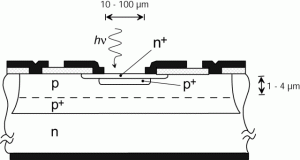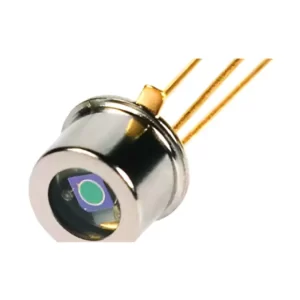Introduction
The Lontenoe InGaAs NFAD is a high-sensitivity single-photon avalanche photodiode designed for near-infrared detection. It operates in the Geiger mode – biased above its breakdown voltage so that even a single photon triggers a large avalanche current pulse. By integrating a negative feedback resistor on the same chip, this device achieves self-quenching of the avalanche and rapid recovery for the next photon. The NFAD’s built-in resistor divides the bias dynamically during a pulse, quickly reducing the voltage across the diode and thus extinguishing the avalanche without external gating. This passive quenching mechanism also significantly reduces afterpulsing (spurious secondary avalanches after a detection) by limiting the total charge flow and trapped carriers in each event. In essence, the Lontenoe NFAD behaves like a solid-state photomultiplier: it outputs a discrete electrical pulse for each detected photon, with low noise and timing precision on the order of a few hundred picoseconds.

Operating Principle of InGaAs NFAD
InGaAs NFADs combine the material advantages of InGaAs/InP APDs with a clever on-chip quenching mechanism. Geiger-mode operation means the diode is reverse-biased a few volts above its breakdown (typically on the order of 60–90 V) so that a single photo-generated carrier can trigger a macroscopic avalanche current. Upon photon absorption in the InGaAs layer, the carrier is accelerated by the strong electric field, causing impact ionization and an avalanche multiplication of charge. The avalanche quickly drives the diode into conduction, producing a fast voltage pulse across a load. In a standard SPAD, an external circuit must detect this pulse and actively quench the avalanche by lowering the bias.
By contrast, the Negative Feedback Avalanche Diode (NFAD) incorporates a thin-film resistive layer in series with the APD junction, on the chip itself. When the avalanche current surges, it automatically develops a voltage drop across this resistor, effectively reducing the bias seen by the APD and quenching the discharge in real-time. The process is self-quenching and self-recovering: once the avalanche stops, the bias gradually restores as the resistor/capacitor network recharges, so the detector is ready for the next photon after a brief dead time (often on the order of ~1 μs, set by design). This passive quench happens on a nanosecond scale without additional electronics, enabling free-running single-photon detection (no gating needed) and greatly simplifying the detector module. The negative feedback also improves reliability by limiting peak current and preventing latching.
A major benefit of the NFAD approach is the reduction of afterpulsing probability. Afterpulsing occurs when charge carriers from an avalanche get trapped in the semiconductor lattice and later release, causing a false trigger. The number of traps filled is proportional to the charge flow during an avalanche. Since the monolithic resistor in the NFAD limits the avalanche charge and shortens the current pulse, far fewer carriers are trapped, cutting down the afterpulse rate. In Lontenoe’s device, the post-pulse (afterpulse) probability is specified as ≤ 30% per event under standard operating conditions (e.g. at 10% photon detection efficiency and 1 µs dead time). With optimized gating or hold-off timing, afterpulsing can be pushed down into the low-single-digit percentage (around 1–3%), which is on par with or better than many actively-quenched APDs.
Another advantage of InGaAs NFADs is their timing performance. The rapid avalanche buildup (sub-ns) and prompt quenching translate to a sharp output pulse. The Lontenoe NFAD achieves a timing jitter (pulse timing uncertainty) of ≤ 350 ps (FWHM) at 10% detection efficiency. This jitter is the combined result of the device’s fast response and low excess noise. Such timing resolution is sufficient for nanosecond-scale coincidence measurements and time-of-flight applications. Researchers have noted that InGaAs SPADs in general can reach timing jitters in the hundreds of picoseconds range, making them suitable for time-correlated single-photon counting (TCSPC) and LiDAR return timing.
Key Applications in Photonics
Single-photon capable InGaAs APDs are indispensable in fields that require detection of extremely weak optical signals at telecom and infrared wavelengths. The Lontenoe NFAD is engineered for these real-world applications:
- Quantum Key Distribution (QKD) and Quantum Communications: Most fiber-optic QKD systems operate at 1310 nm or 1550 nm, where silicon detectors are blind and InGaAs SPADs are the workhorse receivers. In a QKD setup, single photons encoding quantum bits must be detected with high efficiency but low error rates. The NFAD’s moderate photon detection efficiency (PDE) (≥10% guaranteed, with ~15–20% achievable) and low dark count rates make it well-suited for long-distance quantum links. Its self-quenching design supports free-running operation, which is essential for asynchronous QKD protocols (detecting photons that arrive at unpredictable times). By integrating a thermoelectric cooler, the NFAD can be run at low temperatures (–30 °C or below) to further suppress dark counts for quantum cryptography experiments. These features enable secure keys to be distilled over tens of kilometers of fiber. Lontenoe’s device thus addresses the needs of quantum network developers who require compact, reliable single-photon detectors in the NIR band.
- LiDAR and Time-of-Flight Ranging: Eye-safe LiDAR systems often use pulsed lasers at 1550 nm (which falls in the InGaAs sensitivity range) for long-range 3D sensing. Geiger-mode APDs are used in these receivers to detect faint return photons from distant targets. The NFAD’s combination of high gain and low noise allows it to detect single-photon returns amidst background noise. In a typical LiDAR scheme, a short laser pulse is emitted and the SPAD measures the arrival time of the reflected photon pulse to determine distance. The Lontenoe NFAD can be operated with fast gating or in free-running mode at pulse repetition frequencies on the order of tens of kHz (or higher with custom configurations), enabling high-resolution depth maps. Its timing jitter (~0.3 ns) adds only a few centimeters of ranging uncertainty, which is often acceptable for long-distance ranging. Additionally, operating at 1550 nm provides eye safety and allows higher laser powers—this is a wavelength where Lontenoe’s detector has decent PDE and where Excelitas notes its InGaAs APDs are “suitable for eye-safe laser range-finding and LiDAR”. Ruggedized versions of NFAD modules can be used in automotive LiDAR units and atmospheric LiDAR for remote sensing.
- Optical Time-Domain Reflectometry (OTDR) and Fiber Testing: OTDR instruments send a pulse down an optical fiber and use a sensitive photodetector to watch for tiny Fresnel reflections or Rayleigh backscatter returning from fiber faults or splices. In long-haul fibers, the returned signal can be extremely weak after tens of kilometers. A cooled InGaAs SPAD like Lontenoe’s serves as an ideal OTDR receiver, counting single photons returned from far-end fiber events. The low dark count (~kHz or below when cooled) ensures that the noise floor is low, improving the dynamic range and distance reach of the measurement. Furthermore, the NFAD’s built-in fiber coupling (with options for a multimode 62.5 µm core fiber and FC/UPC connector) makes it easy to integrate into fiber-optic test equipment. Similarly, free-space optical communication systems operating at 1550 nm can leverage this detector for receiving single-photon-level signals from distant transmitters (for example, satellite-to-ground laser comm links or deep-space optical communications).
- Low-Light Scientific Instruments: InGaAs single-photon detectors open up detection of weak NIR signals in scientific research. The Lontenoe NFAD can be used in fluorescence lifetime measurements and time-correlated single-photon counting (TCSPC) systems for spectroscopy in the 900–1650 nm range, where traditional PMTs or silicon APDs are ineffective. For instance, NIR fluorescence imaging or upconversion experiments often require single-photon sensitivity at 1064 nm and beyond. With its high gain and low noise, the NFAD enables these measurements with sub-nanosecond timing resolution. Other examples include NIR confocal microscopy, **photon counting in astronomy (laser ranging to satellites, etc.)**, and 3D time-of-flight cameras that use SPAD arrays. Indeed, multi-pixel InGaAs SPAD arrays are being developed for flash LiDAR and high-speed imaging. Lontenoe offers an 8×8 SPAD array module (OP520C) based on similar technology, highlighting the scalability of the NFAD approach to focal plane arrays for 3D imaging and quantum optics experiments.
In summary, wherever near-infrared photons are scarce and precious – from quantum communications to remote sensing – InGaAs NFADs provide the enabling detection capability. They combine the sensitivity of a single-photon counter with the practicality of a semiconductor device that can operate at or near room temperature (with cooling assistance). This makes them practical for field-deployed systems like QKD networks, portable LiDAR units, and telecom monitoring equipment.
Key Specifications and Performance
The Lontenoe InGaAs NFAD module is built to deliver reliable performance under demanding conditions. Table 1 below summarizes the primary specifications from the product datasheet, measured at a typical operating point (chip temperature around –30 °C and PDE ~10%):
Parameter | Value | Test Conditions |
Breakdown Voltage (VBR) | ≤ 100 V | @ 25 °C (10 µA reverse current) |
Photon Detection Efficiency (PDE) | ≥ 10% @ 1550 nm | NFAD chip at ~–30 °C; 1 µs dead time |
Dark Count Rate (DCR) | ≤ 20 kcps | @ PDE = 10%, Tchip ≈ –30 °C |
Afterpulse Probability (AP) | ≤ 30% | @ PDE = 10%, 1 µs hold-off, 50 kHz illumination |
Timing Jitter (FWHM) | ≤ 350 ps | @ PDE = 10%, 1550 nm, 50 kHz rep rate |
Optical Wavelength Range | 0.95 – 1.65 µm | (InGaAs absorption range) |
Active Area Diameter | ~25 µm (typical) | (Estimated from similar devices) |
Dark Current (below VBR) | ≤ 2 nA | @ ~room temp, Vbias ~ VBR –1 V |
Capacitance | ~0.5–0.6 pF | @ 1 MHz, just below breakdown |
TEC Cooling | Integrated thermoelectric cooler | (Butterfly package version) |
Operating Temperature | –50 °C to +70 °C (ambient) | (With TEC maintaining chip at –30 °C to –50 °C) |
Storage Temperature | –55 °C to +75 °C |
|
Max. Incident Optical Power | ~10 nW (counting regime) | (Avoid saturating the detector) |
ESD Sensitivity | ~250 V (HBM) | Handle with standard ESD precautions |
Notes: The PDE is the probability of registering a count per incident photon – it factors in quantum efficiency and avalanche trigger probability. Lontenoe guarantees ≥10% at 1550 nm, but typical operation can achieve 15% or higher by increasing the overbias. The DCR (dark counts per second) is measured at that efficiency; lower DCR is possible at lower PDE or colder temperatures. In practice, Lontenoe reports dark count rates on the order of 0.5–1.5 kcps (500–1500 cps) when the device is cooled to around –25 °C. The maximum 20 kcps spec represents a worst-case at higher ambient temps or initial breakdown voltage tolerance. Similarly, afterpulse probability can be reduced well below the 30% maximum by adjusting the dead time (e.g. using a longer hold-off or gating at lower repetition rates). The timing jitter of 0.35 ns is a conservative upper limit – many pulses will have much sharper timing, but this figure ensures design headroom for system integrators. The NFAD is also relatively low capacitance (~0.5 pF), which translates to fast pulse edges and easier impedance matching in readout circuits.
Design and Packaging Highlights
One of the standout features of Lontenoe’s NFAD product is its integrated thermoelectric cooler (TEC) and flexible packaging options. The NFAD chip is mounted on a ceramic carrier with a built-in miniature TEC and thermistor, all sealed in a compact module. By actively cooling the APD chip to around –30 °C (or as low as –50 °C for optimal noise performance), the device achieves dramatically lower dark currents and dark counts than it would at room temperature. The TEC maintains a stable low temperature setpoint, which not only cuts down thermal noise but also stabilizes the breakdown voltage (since VBR shifts with temperature at ~0.1–0.15 V/°C). This means the bias point and detection efficiency remain consistent over the specified –50 °C to +70 °C ambient range, an important consideration for outdoor or field deployments.
Lontenoe offers the NFAD module in two packaging styles to suit different integration needs: a fiber-coupled “butterfly” package and a more compact TO-46 can variant. The butterfly package is a gold-plated housing (approximately 22 × 26 mm footprint) with multiple pins and a fiber pigtail. It contains the TEC, temperature sensor, and often a pre-aligned fiber input. The optical input is typically a 62.5 µm core multimode fiber with an FC/UPC connector, actively aligned to the APD for maximum coupling efficiency. This results in a hermetically sealed, single-channel detector module that can be directly attached to fiber-optic setups. The butterfly module runs on standard TEC driver voltages (≲12 V, <0.8 A max for the cooler) and allows closed-loop temperature control of the APD chip. The TO-46 can version, on the other hand, is a miniaturized coaxial package with a built-in fiber stub or lens – ideal for situations where size is critical and the application can manage with passive cooling or external thermal control. The TO-46 variant still features a hermetic metal can with a window or fiber feed-through, ensuring the APD is shielded from moisture and contamination.

High Quantum Efficiency & Responsivity: The InGaAs absorption layer in the NFAD is optimized for the 1.0–1.6 µm band, giving a high quantum efficiency (QE). Internally, the APD structure is engineered for ≥8 A/W responsivity at 1550 nm in linear mode with gain. Under Geiger-mode operation, this corresponds to a PDE around 15–20% as mentioned earlier. Notably, Lontenoe’s claimed responsivity (with avalanche gain) is extremely high – comparable to or exceeding that of other leading manufacturers’ APDs. This means each photon yields a strong electrical response, which can ease the requirements on downstream amplifiers or discriminators. High responsivity is a direct result of high avalanche gain and efficient fiber coupling, and it enables longer detection ranges or lower detection thresholds in photon-starved applications.
Low Noise and Reliability: The use of a monolithic resistor and low-defect InGaAs/InP material gives the NFAD exceptionally low leakage current (≪1 nA at operating bias) and low dark count rates. Lontenoe specifies a dark current ≤2 nA near breakdown, which is substantially lower than typical values for comparable APDs (competitors often report tens of nA of dark current at room temperature). This low dark current is the foundation for achieving dark count rates in the kHz range. Additionally, all components are hermetic and fiber-coupled, ensuring stable long-term operation. The device is rated for a wide temperature range and can handle moderate shock and vibe, similar to telecom laser modules. An ESD rating of ~250–300 V HBM means the device is somewhat ESD-sensitive; thus, standard handling procedures (grounded wrist straps, antistatic workstations) are required to avoid damage. The NFAD’s high reliability is emphasized by the manufacturer – it’s built for applications like quantum comms and aerospace where consistent performance over time is critical. The built-in feedback resistor also protects the APD from burnout by limiting current on each avalanche, which adds a measure of safety compared to unprotected APDs.
In short, the Lontenoe NFAD module represents a highly integrated solution: it combines an advanced InGaAs SPAD chip, passive quenching mechanism, TEC cooling, and fiber coupling. This integration simplifies the work of system integrators, who get a turn-key single-photon detector that can be biased with a single high-voltage supply (around 60–80 V) and controlled via a TEC driver. The result is a compact yet powerful detector that brings single-photon sensitivity to the infrared realm with relative ease of use.
Comparison with Competing NFAD/SPAD Detectors
How does Lontenoe’s InGaAs NFAD stack up against other single-photon avalanche photodiodes on the market? Table 2 provides a comparison of key parameters between Lontenoe’s device and representative InGaAs SPAD offerings from **Princeton Lightwave (PLI), ID Quantique (IDQ)**, and Excelitas – three leaders in this technology space. (Note: Princeton Lightwave was acquired by Excelitas, but we list it separately here for its well-known products in research.) These competitors have developed InGaAs SPADs for photon counting, each with different design philosophies (e.g. some require external quenching or gating, others use active cooling). For fairness, we compare typical performance around the 10–20% PDE level at telecom wavelengths:
Table 2: Performance Comparison of Lontenoe NFAD vs. Competing InGaAs SPADs
Parameter (at ~1550 nm) | Lontenoe InGaAs NFAD(free-running) | Princeton Lightwave SPAD(PGA-XX series) | ID Quantique ID230(free-running module) | Excelitas InGaAs SPAD(SLiK or similar) |
Photon Detection Efficiency | 10–15% (min. 10%, typical 15–20%) | ~20% (typical at 233 K, 3 V overbias) | 10–25% (tunable; 10% for lowest noise, up to ~25% max) | ~20% (typical, in gated mode) |
Dark Count Rate(@ ~10% PDE) | ~1e3 cps (@ –30 °C)≤ 20 kcps max | ~100e3 cps (100 kcps at –40 °C, 20% PDE) | ~50 cps at 10% PDE (with ultra-cooling to –90 °C); a few kHz at 20% PDE | ~5e3 cps (5 kcps typical at 20% PDE, with cooling) |
Timing Jitter (FWHM) | ~300–350 ps | ~300 ps (estimated, not explicitly in datasheet) | ~150–200 ps (typical) | ~200–300 ps (in gated mode) |
Afterpulse Probability | ~2% (with 1 µs hold-off at 1.25 GHz gate); ≤30% worst-case free-running | Not stated (depends on external quenching; passive NFAD diode itself can be low) | <1% (with long hold-off >10 µs; actively quenched) | ~5% (typical for gated operation at few µs dead time) |
Operating Temp. Range | –50 to +70 °C ambient (TEC holds chip at –30 °C) | Typically cooled to –40 °C for specs; 0 to +60 °C ambient | Requires deep cooling: e.g. Stirling cooler to –90 °C (module ambient 0 to +40 °C) | 0 to +50 °C (typical module ambient with TEC) |
Special Features | Integrated TEC; passive quench resistor on-chip; fiber-coupled module | Discrete SPAD (requires external quench circuit; available in TO can) | Complete module with active quenching & adjustable hold-off; Stirling cooler option for ultra-low DCR | “SLiK” low-noise APD diode (InGaAsP absorber); used in many gated detector units (e.g. Laser Components modules) |
Data sources: Lontenoe NFAD specs from datasheet and internal testing; Princeton Lightwave from PGA-246-25 datasheet; ID Quantique ID230 from literature and product notes (e.g. ~50 cps at 10% efficiency with cryogenic TEC); Excelitas values inferred from Excelitas’s C30659 series and “Count” module documentation, as well as independent comparisons.
From the above comparison, several points emerge:
- Detection Efficiency: All these InGaAs SPADs reach roughly 20–25% PDE at 1550 nm in best-case operation. Lontenoe’s device, with ≥10% guaranteed, is in the same class, achieving ~15% in typical use (and potentially higher with a bit more overbias). This is comparable to Princeton Lightwave’s established APDs and IDQ’s module (which peaks around 20–25% as well). Excelitas’s “SLiK” linear-mode APDs boast very high QE (>70%), but that is at linear gain; when used in Geiger mode with quenching circuits, the effective PDE is similar (~20%). In short, Lontenoe provides competitive single-photon efficiency for telecom wavelengths.
- Dark Count Rate: Lontenoe’s NFAD excels in achieving low dark counts without extreme cooling. At around –30 °C (easily achieved with a TEC), it has on the order of 10^3 cps dark count, which is low enough for many applications. In contrast, an older PLI diode at –40 °C had ~100 kcps at 20% efficiency – two orders of magnitude higher dark noise (this is partly why many early QKD systems gated their APDs to reduce average dark counts). ID Quantique’s ID230 module pushes dark counts to the tens of counts per second (!), but only by using a Stirling cooler to reach ~–90 °C – essentially a miniature cryocooler, which is power-hungry and bulky. Lontenoe strikes a balance by achieving low DCR with just a thermoelectric cooler, avoiding the complexity of cryogenic cooling. Excelitas’s APDs, when used in gated mode with a long dead-time, typically give a few kcps DCR at 20% PDE (and can go lower at lower PDE), which again is in the same ballpark as Lontenoe’s performance at moderate cooling. Bottom line: for free-running operation, Lontenoe offers very low dark noise relative to most APDs that aren’t cryogenically cooled.
- Afterpulsing: Thanks to the negative feedback design, Lontenoe’s afterpulse probability is moderate (~1–2% in certain gated conditions, or up to a few tens of percent worst-case free-running). Competing approaches handle afterpulsing by either using long hold-off times (IDQ actively quenches and imposes, say, 10 µs delays, to reduce afterpulses to <1%) or by special APD fabrication (Excelitas’s “SLiK” diode structure is optimized for low afterpulsing in gated mode). Princeton Lightwave’s NFAD diodes were among the first to demonstrate much lower afterpulse than conventional APDs, so Lontenoe is building on that heritage. In practice, all these detectors can achieve acceptably low afterpulse with proper settings; Lontenoe’s advantage is that its inherent passive quenching handles much of this without complex electronics.
- Timing Jitter: All compared devices have sub-nanosecond timing resolution. Lontenoe’s ≤350 ps spec is slightly higher than some state-of-art modules (IDQ quotes ~150 ps for their best), but still within a factor of 2. For many applications (e.g. 1 ns laser pulse discrimination, LiDAR over hundreds of meters), 0.3 ns vs 0.15 ns will not be the limiting factor. If needed, Lontenoe’s jitter might be improved by operating at higher bias (to shorten avalanches) or using impedance-matched faster readout. Notably, superconducting nanowire detectors can achieve <50 ps jitter, but those require entirely different cryogenic systems. Among InGaAs APDs, a few hundred picoseconds is typical and Lontenoe’s device is in family.
- Operational Convenience: Lontenoe’s module is designed for turn-key integration – just provide a bias voltage (up to ~5 V above VBR) and manage the TEC, and you get free-running photon counting. Princeton’s APDs were often sold as bare diodes that required customers to design quenching/reading circuits. ID Quantique provides a full package (with quenching and even gating options), but at the cost of a large cooler and higher price. Excelitas provides APD chips (and some modules in partnership with others), but again, not with monolithic quenching – typically an external active quench circuit is used. So Lontenoe’s NFAD module blends the best of both: an elegant device-level solution (monolithic resistor) with a convenient packaged module. The comparison in Lontenoe’s own analysis concluded that their SPAD “blends the high responsivity and low-noise figures of top InGaAs APDs with the single-photon capability of gated SPADs” – effectively offering a ready-to-use photon counter for NIR.
In conclusion, Lontenoe’s InGaAs Negative Feedback APD stands out as a cutting-edge single-photon detector that addresses the pain points of earlier InGaAs SPADs. It achieves a respectable detection efficiency and sub-ns timing while keeping dark counts and afterpulsing to manageable levels – all in a compact, TEC-cooled module. Engineers and researchers can integrate this NFAD into their systems (whether it’s a quantum communication setup, a LiDAR receiver, or a single-photon experiment) to immediately gain single-photon sensitivity at 1550 nm without needing to build complex quenching electronics or cryogenic cooling. By leveraging the negative-feedback quenching mechanism pioneered by PLI and others, Lontenoe delivers a robust engineering solution: a photodiode module that offers the functionality of a single-photon counter with the practicality of a standard photodiode. This combination of performance and practicality is what makes the Lontenoe InGaAs NFAD a compelling choice for next-generation photonics systems.






